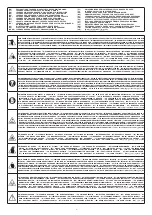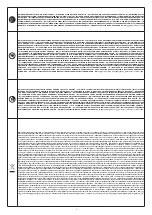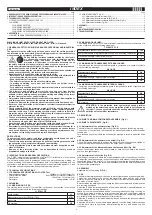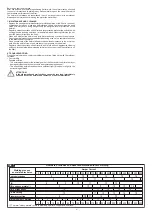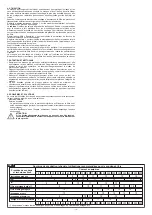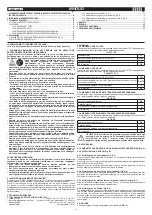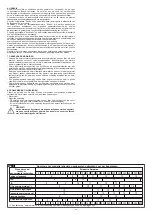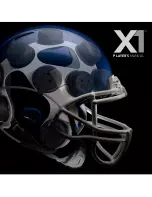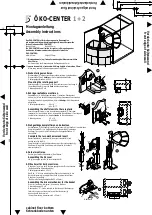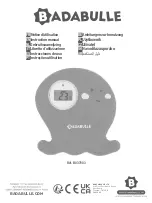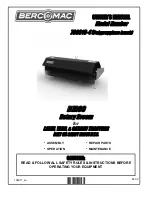
- 5 -
WELDING HELMETS WITH FIXED GRADATION FILTER.
NB: In the text that follows, the term “helmet” and “filter” will be used.
1. GENERAL SAFETY FOR HELMET USE AND PROFESSIONAL AND INDUSTRIAL
USE
The operator must be sufficiently trained on safe use of the welding machine
and informed on the risks relating to arc welding procedures, the relevant safety
measures and the emergency procedures.
•
During welding, luminous radiation emitted by the electric
arc can damage eyes and burn skin; furthermore, welding
produces sparks and drops of molten metal can be
projected in all directions. It is therefore necessary to use
the safety helmet to avoid physical injury, which may even be serious.
• Avoid the welding helmet catching fire, for any reason, as the fumes produced
are harmful to eyes and, if inhaled, for the body.
• The material composing the complete helmet is free of hazardous substances
and does not present any risk for man or the environment.
• Regularly check the condition of the helmet and the filter:
- Before each use, check correct positioning and fastening of the filter and the
protective plates which must be exactly in the space described.
- Keep the helmet far from flames.
- The helmet must not be too close to the welding area.
- In prolonged welding, every now and then check the helmet for any
deformations or wear.
- For particularly sensitive people, the materials that come in contact with the
skin could cause allergic reactions.
• This helmet is only certified to protect the face and eyes from harmful
ultraviolet and infra-red radiation, from sparks and welding sprays; it is not
suitable for laser welding and oxy-acetylene welding and cutting or to protect
the face from explosions or corrosive liquids.
• Only replace helmet parts with others specified in this manual. Non-compliance
with this regulation can expose the operator to health risks.
• Protect the filter and the protective plates from contact with liquids and dirt.
• Never use the helmet without the internal or external transparent protective
plates of the filter.
• Check compatibility of the protective plates of the filter and the helmet: both
should be marked with the same impact resistance symbol against high speed
particles, in this case F. If the marking symbols are not common to both, the
protective plates of the filter and the helmet, then the lowest protection level
of the helmet-filter assembly should be used.
• The eye protection against high speed particles worn over standard glasses
can produce impact, thereby creating hazards for those who wear them.
• Do not use spare parts other than original TELWIN parts.
Unauthorised modifications and replacement with non-original parts will void
the warranty and expose the operator to the risk of personal injury.
• Remember to use the helmet, the filter and the relevant protective plates for a
maximum of 2 years. The duration of these items depends on various factors
such as the frequency of their use, cleaning, storage and maintenance. You
are advised to frequently inspect and replace if damaged.
PRECAUTIONS
To protect the user’s safety, read these instructions carefully and consult a
qualified instructor or supervisor before starting work.
• These filters and protection plates can be used in all welding processes, with
the exception of oxy-acetylene welding and laser welding.
• The light protection plate in standard polycarbonate must be applied on both
sides of the filters.
• Non-use of the protection plates can be hazardous for safety or cause
irreparable damage to the filter.
2. INTRODUCTION AND GENERAL DESCRIPTION
The “TWFR” model helmet is composed of a filter TH11; furthermore, it is composed
of transparent external and internal front guards.
The helmet was designed to guarantee correct eye protection during welding, as
well as providing the maximum performance both in facilitated assembly and the
convenience and quality of use: it guarantees permanent protection against UV and
IR radiation and sparks generated during the arc welding process.
3. TECHNICAL SPECIFICATIONS
3.1 TECHNICAL SPECIFICATIONS OF FILTER TH11
- Overall measurements:
108x51mm,110x90x10mm (XL)
- Filter protection plates:
front 110x90mm, internal 110x90mm
- Visual area:
100x47mm, 101x81mm (XL)
- Dark state:
fixed gradation 11 DIN
3.2 MARKING
3.2.1 MARKING ON FILTER
The marking found on the TH11 model filter, on the upper front section, is composed
of a series of symbols with the following meanings:
11 XTW 1 CE
scale number
11
Manufacturer’s symbol: TELWIN ITALY
XTW
optic class
1
CE marking
CE
3.2.2 MARKING ON HELMET
The marking found on the TWFR helmet internal lower front section is composed of a
series of symbols with the following meanings:
TW EN175 F CE
Manufacturer’s symbol: TELWIN ITALY
TW
numerical standard of legislation referenced when requesting certification
EN175
mechanical strength: impact at low energy
F
CE marking
CE
3.2.3 MARKING ON TRANSPARENT EXTERNAL GUARD
The marking on the transparent external guard is composed of a series of symbols
with the following meanings:
GX 1 B CE
Manufacturer’s symbol:
GX
Optic class
1
mechanical strength: impact at medium energy
B
CE marking
CE
3.2.4 MARKING ON TRANSPARENT INTERNAL GUARD
The marking on the transparent internal guard is composed of a series of symbols with
the following meanings:
GX 1 B CE
Manufacturer’s symbol:
GX
optic class
1
mechanical strength: impact at medium energy
B
CE marking
CE
ATTENTION: If the protection letter against high speed particles
marked on the helmet and on the protection plates is not followed by
the letter T, then an eye shield should be used against the high speed
particles only at ambient temperature.
4. DESCRIPTION
4.1 HELMET AND MAIN COMPONENTS ASSEMBLY (Fig. A)
4.2 HELMET ADJUSTMENTS (Fig. B)
4.2.1 Adjustment of the perimeter strap (Fig. B-1)
The helmet must be adjusted to efficiently protect the eyes and face during welding.
The position of the front and rear strap can be manually adjusted to perfectly adapt
to head size.
Turn the knob (in some models, the knob must be pressed to turn it) to adapt the head
strap.
4.2.2 Adjustment of the perimeter strip height (Fig. B-2)
The height can be adjusted to position the strap just over the eyebrows: tighten or
loosen the two graduated belts placed on the upper part of the head.
4.2.3 Adjustment of the distance between the face and filter (Fig. B-3)
Loosen the external knobs and slide forward or back until you obtain the desired
position, then tighten again.
4.2.4 Adjustment of inclination (Fig. B-4)
Ideal tilting of the helmet is where the eyes are perpendicular to the surface of the filter.
To adjust the visualisation angle, loosen the knobs on both sides of the helmet and set
the desired tilting of the helmet. If it is not possible to obtain the desired tilting, press
the side buttons and move the cursors simultaneously so that the helmet goes beyond
limitation of the preset angle.
5. ASSEMBLY
Assemble as in the drawing (
FIG. A
).
6. USE
The helmet must always and only be used to protect the face and eyes during welding.
The helmet and therefore the zone of the visual filter glass must be kept, during
welding, as near as possible to the eyes to protect them from luminous radiation and
any drops of molten metal.
Before starting the welding process, check the filter, the external and internal guards
are correctly positioned.
Adjust the “Shade” luminous gradation, in the models where this is possible, based on
the current and the welding procedure.
Table 1
gives the recommended “shade” luminous gradation numbers for using an
electric arc welding machine to carry out common jobs and the different welding
current intensity levels. Check the intensity of the current and the welding procedure
are suitable for the luminous gradation of filter protection.
Adjust the “Sensitivity”, in the models where planned, based on the luminous intensity
of the welding arc.
Adjust the “delay-time, in the models where planned, to set the delay time for passage
from the dark state to light state, after interrupting the arc and based on piece
luminosity.
ENGLISH
INDEX
1. GENERAL SAFETY FOR HELMET USE AND PROFESSIONAL AND INDUSTRIAL USE ..................5
2. INTRODUCTION AND GENERAL DESCRIPTION .................................................................................5
3. TECHNICAL SPECIFICATIONS ..............................................................................................................5
3.1 TECHNICAL SPECIFICATIONS OF FILTER TH11
...........................................................................5
3.2 MARKING
..........................................................................................................................................5
3.2.1 MARKING ON FILTER
.............................................................................................................5
3.2.2 MARKING ON HELMET
..........................................................................................................5
3.2.3 MARKING ON TRANSPARENT EXTERNAL GUARD
............................................................5
3.2.4 MARKING ON TRANSPARENT INTERNAL GUARD
..............................................................5
4. DESCRIPTION .........................................................................................................................................5
4.1 HELMET AND MAIN COMPONENTS ASSEMBLY (Fig. A)
...............................................................5
4.2 HELMET ADJUSTMENTS (Fig. B)
....................................................................................................5
4.2.1 Adjustment of the perimeter strap (Fig. B-1)
............................................................................5
4.2.2 Adjustment of the perimeter strip height (Fig. B-2)
..................................................................5
4.2.3 Adjustment of the distance between the face and filter (Fig. B-3)
...........................................5
4.2.4 Adjustment of inclination (Fig. B-4)
..........................................................................................5
5. ASSEMBLY ..............................................................................................................................................5
6. USE
................................................................................................................................................5
7. MAINTENANCE AND CLEANING...........................................................................................................
6
8. TROUBLESHOOTING .............................................................................................................................
6
page
page
Summary of Contents for 802812
Page 57: ...57 Fig A...
Page 58: ...58 Fig B 1 2 3 4...


